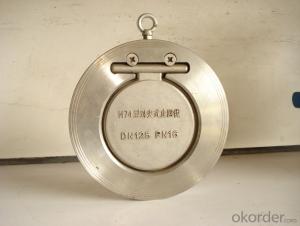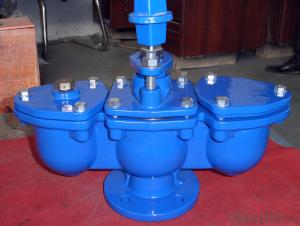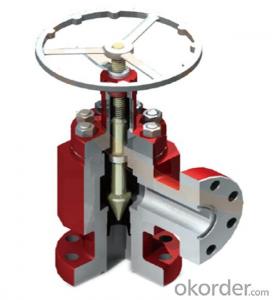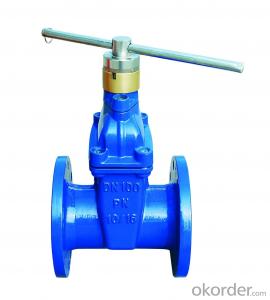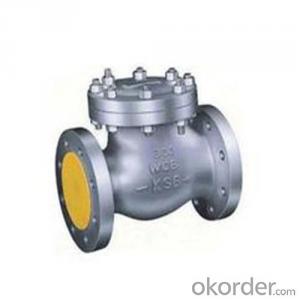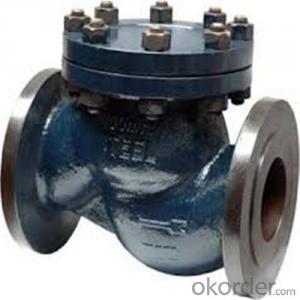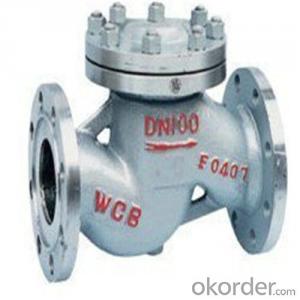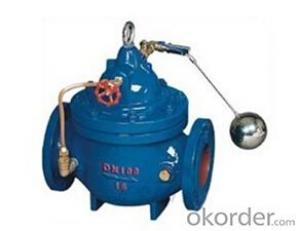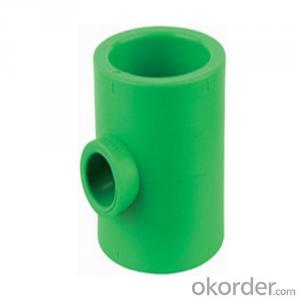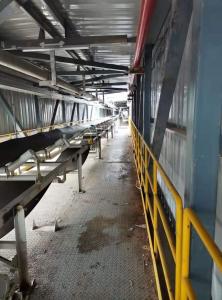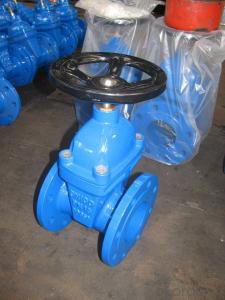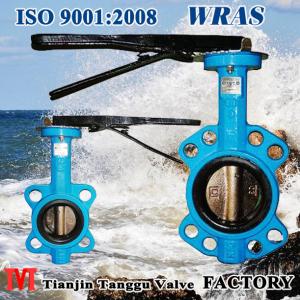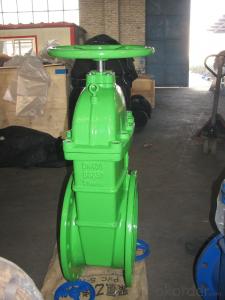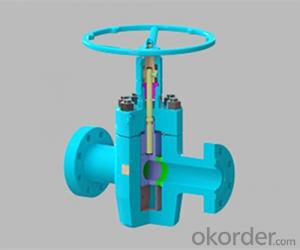Stainless Steel Wafer Type Check Valve
- Loading Port:
- China Main Port
- Payment Terms:
- TT OR LC
- Min Order Qty:
- -
- Supply Capability:
- -
OKorder Service Pledge
OKorder Financial Service
You Might Also Like
Specifications
Stainless steel check valve
PN10/16/25
DN100 ~ DN2000
Technical Specifications
- Design and manufacture: EN593, EN1074-1 and 2
- Face to face dimension: EN558-1 Series 14 (DIN3202 F4)
EN558-1 Series 13 (BS5163)
- Flange dimensions and drillling: EN1092-2 PN10/16/25
- Size range: DN100 - DN2000
- Max. working pressure: 1.0/1.6/2.5 MPa
- Inspection test: EN12266
- Working temperature: -15°C to +80°C
- Suitable medium: water
Main Fetures
- Double eccentric disc reduces seal wear and torque
- Body seat ring is welded directly on the body
- Bi-directional flow and low head loss
- Disc sealing ring to be replaceable on pipeline without dismantling the valve
- Body and disc inside and outside epoxy powder coated (min. 250 microns)
- Opening and closing indicators are provided
- Coupling flange for electric actuator in compliance with ISO5211
- Gearbox and electric actuator operation available
Main Parts and Materials
Body and disc: ductile iron EN GJS500-7/400-15
Shafts: stainless steel AISI 420
Body seat ring: stainless steel AISI 304
Disc sealing ring: EPDM or NBR
Retaining ring: stainless steel or ductile iron
Shaft bearing: Du bushes (self lubricating bushes)
Shaft bush: gunmetal
- Q:I have a 3406b motor. It has blow by. This happened when I hired a mechenic to do a top end. I belive that he did not ajust the valves correctly or something happen to the motor. I want to gap the valves to see if this helps out. How would I go on doing this.
- NO, valves does not contribute to blow by in this way.Blow-by is the compression of the cylinder getting past the piston rings during compression. Adjusting the valves is a procedure of the induction and exhaust systems. All engines experience a little blow-by which is supposed to pass through the PCV valve ventilating the crankcase. GOOD-LUCK!! BRILLIANT!!!!
- Q:I have 3 such valves in the line and none seem to be able to move past 10/4 oclock position and water remains on. Is there a way to adjust valve? Seems there is slot for screwdriver in center of valve.
- The threads are stripped, you will have to get a new one, until then shut off main line into house if you are flooding
- Q:My furnace cut out about a year ago. The hvac guy i used told me the gas valve was no good and that the flu was partially blocked. I cleaned out the flu, he replaced the gas valve ($700+) and it worked great for a year. Today the furnace does not fire up. Pilot is working. I cleaned out the flu (there was definitely quite a bit of debris, so that was probably the cause for the shut off) .... The flu is now clear, but when i turn the system back on the thermostat calls for heat, but there is no gas flow to the burner... could the valve have failed that quick, or should i be looking at something else like the CO sensor or something... just looking for some direction before shelling out another 700 bucks... Thanks in advance for any ideas or assistance....
- There are a few possibilities. The valve runs on a low voltage line. The low voltage is provided by a transformer. It it possible the transformer is bad. Be sure the power switch to the furnace is on. (should be on the side of the furnace. Easy way to check is (on the thermostat) turn the fan switch from auto to run. The blower fan should come on. Check that the gas valve is in the ON position.(if you have had to light the pilot it may still be in pilot position.) Another possibility is a clogged gas line. If you have an older home rust can accumulate inside the iron gas lines. Where the gas line attaches to the furnace there should be a drip leg. This is a short length of pipe that points down with a cap on it from the TEE that goes into the furnace. This short piece of pipe is to catch any moisture or rust that comes thru the line. First TURN OFF the gas at the shut off in the pipe it's self. This is a quarter turn valve. When the handle is in line with the pipe the gas is on. When it is opposite the pipe (pointing out to the side) the gas is off. After turning the gas off, remove the cap from the bottom of the drip leg to remove any accumulation.USE PIPE DOPE not teflon tape when putting the cap back on.Turn the gas valve back on and check for leaks.
- Q:How are they different from other valves ?
- Test valves are typically needle valves but I have seen some occasional usage of 1/4 to 1/2 inch globe valves and ball valves used as test valves for sampling. Pressure gauge installations may have test valves installed just below them. The valves are used to isolate the gauge from the system pressure, a second valve is used to vent the trapped pressure so the gauge could return to zero. The same vent valve could then be used to attach a calibrated pressure source to the pressure gauge so as to check (qualify) the gauge reading against the standard. This was done on select gauges where a quick in place qualification could be done without the need to physically remove the gauge from the gauge board. I have also seen test valve setups in systems using a three way valve in a setup to scavenge the sensing line with a clean fluid. This is done when dealing with a slurry which could block the sensing line suach as in a quick lime system. Clean water would flush the line before and after a reading so as to not trap material in the sensing line which could build up and block or cause a false reading. Test valve location also gives a handy mean to obtain a sample of the process fluid.
- Q:hi guys..What is different between globe valve and stop check globe? Is that stop check globe=SDNR JIS std?
- Sdnr Globe Valve
- Q:My baritone is somewhat new, the first valve isn't going down, I've tried nearly everything and I want to avoid taking school instrument to a music store to repair.
- Obviously there is something wrong with the first valve. Take out the entire first valve and pick it apart is all I can say even after 4 years of playing one. More than likely the first valve is not put on straight or just needs to be greased.
- Q:Would it be cheaper to get a toyota Valve body U140/240 repaired or would it be easier to swap it out... by the way the transmission valve body would cost $780
- LOL okorder DETROIT MICHIGAN! $780, my SORE LEFT FOOT!
- Q:2004 R6. Runs really well... never had a problem. Has 24K miles on it. Yamaha calls for them to get readjusted at the 26,600 mile mark. So I have a few thousand more and then I'm gunna have them adjusted.I can already hear them tick especially at idle because when riding, my exhaust is so loud and all you can hear is that and the wind. Anyway, this time will come up before I know it.Just curious... what happens if the valves remain loose? Will it affect performance? How do you they become loose and is it ok to ride a bike with them like that... atleast until the specific mileage when they are supposed to be adjustd?
- Yes .....your throttle responce is the worst. Because the valve is not opening wide enough for the air to flow properly. Adjusting valves is real simple. it only takes a feeler gauge and a screwdriver / wrench. You just get the gauge so it drags/scratches on it's way out from in-between the rocker arm and valve tip. There should be a little resistance when pulling it out. But it should not be stuck .......or the adjuster screw is too tight. It only takes small 1/8 turns to get the movable grab you want in the feeler gauge. You can keep riding it that way..........but it will only get worse with time. Because the rocker arm starts to whack the top of the valve instead of tap it down. With it loose, the valve is not getting the full opening stroke it should. Eventually you will have to get it fixed from hard staring and lagging performance
- Q:I mean dropping the valve seat. And some mechanic told me that it dropped when the catalytic converter got clogged and it hurt the engine. But the most I've heard is that if I want to avoid this from happening I should be running the engine a bit colder because the valves weren't made with the right specs and after a 100,000 miles they become a bit loose and when the engine gets to the normal temperature or just a bit above, the valve seats would drop. Does ANYONE KNOW ANYTHING ABOUT THIS?
- If the valve has dropped you will hear a ticking nose when the engine is running. It the valve hitting the piston. This need to be fixed ASAP, With a stuck valve you will experance back firing or lots of smoke could out of the tall pipe especially on acceleration. Either way if you are trying to keep your car I would have the problem correctly diagnosed and this will likely means you will need a top end rebuild. These little 1.9L ford engines were pretty tough but after XX amount of miles and so many years it time for some internal engine work.
- Q:Surly Pilots don't just switch the fuel selector valve of mid flight
- Do you know for certain that it was, or are you just repeating unfounded rumors? What's your source for this information?
1. Manufacturer Overview |
|
|---|---|
| Location | |
| Year Established | |
| Annual Output Value | |
| Main Markets | |
| Company Certifications | |
2. Manufacturer Certificates |
|
|---|---|
| a) Certification Name | |
| Range | |
| Reference | |
| Validity Period | |
3. Manufacturer Capability |
|
|---|---|
| a)Trade Capacity | |
| Nearest Port | |
| Export Percentage | |
| No.of Employees in Trade Department | |
| Language Spoken: | |
| b)Factory Information | |
| Factory Size: | |
| No. of Production Lines | |
| Contract Manufacturing | |
| Product Price Range | |
Send your message to us
Stainless Steel Wafer Type Check Valve
- Loading Port:
- China Main Port
- Payment Terms:
- TT OR LC
- Min Order Qty:
- -
- Supply Capability:
- -
OKorder Service Pledge
OKorder Financial Service
Similar products
New products
Hot products
Hot Searches
Related keywords
